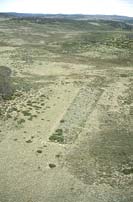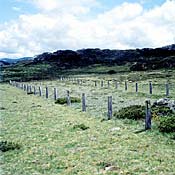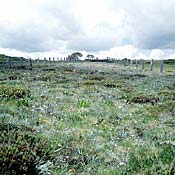 |
Aerial view of Maisie’s Pretty Valley cattle exclusion plot
(click to enlarge)
|
Cattle grazing in the High Country affects the spread of fire in a number of ways. While a heavily grazed area may slow the movement of fire, grazing can change the composition of plants in the landscape over time, and these changes can considerably increase the flammability of the landscape. In particular, cattle eat back fleshy, fire-resistant plants, and they promote the growth of oil-rich, flammable shrubs.
A clever study demonstrates this very well.
In 1945 Maisie Fawcett, a pioneering botanist from Melbourne University, fenced cattle out of a couple of small areas on the Bogong High Plains south of Falls Creek. One of them, the ‘Pretty Valley Plot’, was set up to test a theory she had about these grasslands.
She noticed that the many bare patches caused by cattle in the grasslands were generally colonized by shrub seedlings, rather than new grass tussocks or the more fleshy-leaved plants of the High Country. Apparently these shrubs were able to handle the more severe frost in the small hollow.
She also noticed that, as the seedling shrubs grew and eventually died off, they sheltered the regrowth fleshy plants. But with cattle around, any fleshy plants the shrubs had sheltered were eaten back again.
Maisie thought that, if cattle were excluded, the plot would initially have an increased shrub growth (caused by the bare patches), but that as these shrubs died-off, the fenced area would be full of fleshy-leaved plants amongst the tussocks of grass.
This is exactly what happened.
Silver Snow Daisies now occupy about 40% of the ungrazed plot, compared to about 5% of the nearby grazed area. Other plants, like Billy Buttons, Thick Eyebright and Alpine Podolepis are also far more common in the ungrazed plot.
These plants tend to be fairly fire resistant.
The experiment shows us what the High Plains might once have looked like: rich with an abundance of flowering alpine plants. It is not surprising that the first cattlemen to come to the High Plains called this area ‘Pretty Valley’.
The plot has been monitored by scientists continuously, and is one is one of the longest running plant ecology experiments in Australia.
 |
 |
Outside and inside Maisie’s Pretty Valley cattle exclusion plot. The area inside the fence has not been grazed by cattle for over 60 years
(click to enlarge)
|
|